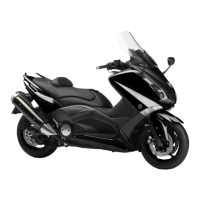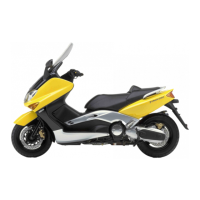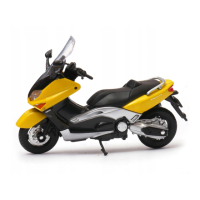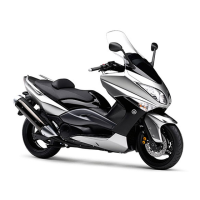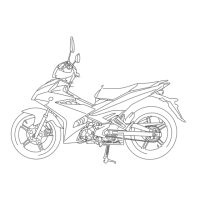Do you have a question about the Yamaha TMAX XP500 and is the answer not in the manual?
Additional advice for safe operation of the scooter, covering various road conditions and rider behavior.
Diagram illustrating the left side of the scooter with numbered parts.
Diagram illustrating the right side of the scooter with numbered parts.
Identification and layout of the scooter's controls and dashboard instruments.
Explains the ignition, lighting, and steering lock functions and positions.
Details dashboard indicator lights, their meanings, and functions.
Covers speedometer, odometer, tripmeter, and fuel gauge operation.
Instructions for setting the clock and information on the coolant temperature gauge.
Details handlebar switches, self-diagnosis, and optional anti-theft alarm.
Explains front/rear brake levers and fuel tank cap operation.
Instructions for opening the seat and adjusting the rider backrest.
Information on shock absorber handling and helmet holder usage.
Details storage compartments and sidestand operation.
Explanation of the ignition circuit cut-off system and its safety functions.
A comprehensive list of daily checks for vehicle safety and readiness before operation.
Instructions for starting the engine and safely beginning to ride.
Guidance on braking, fuel saving, and engine break-in procedures.
Safe methods for parking the scooter, considering heat and stability.
Details on the location and use of the owner's tool kit for maintenance.
Schedule of regular checks, adjustments, and lubrication for optimal performance.
Step-by-step guide for removing and refitting body panels for maintenance access.
Procedure for inspecting spark plugs to assess engine condition.
Instructions for checking engine oil level and replacing the oil filter.
Procedure to reset the oil change indicator and maintain chain drive oil.
Guidance on checking and maintaining the scooter's coolant level.
Steps for cleaning the air filter element to ensure proper engine air intake.
Procedure for checking and adjusting engine idling speed and carburetor settings.
Instructions for adjusting valve clearance and throttle cable free play.
Details on tire specifications, air pressure, loading, and inspection.
Information on checking cast wheels, front/rear brake pads, and rear brake pads.
Instructions for checking brake fluid level and identifying potential issues.
Guidance on lubricating throttle grip, brake levers, centerstand, and sidestand.
Procedures for checking the front fork, steering, and wheel bearings.
Information on the sealed-type battery, its maintenance, and charging.
Step-by-step guides for replacing fuses and headlight bulbs.
Overview of troubleshooting, diagnostic charts, and addressing engine overheating.
Guidelines for regular cleaning and maintenance to preserve appearance and function.
Instructions for short-term and long-term storage to protect the scooter.
Detailed technical specifications for the scooter's various components.
Table for converting metric units to imperial units used in specifications.
Information on recording key, vehicle identification numbers, and model label.
Additional advice for safe operation of the scooter, covering various road conditions and rider behavior.
Diagram illustrating the left side of the scooter with numbered parts.
Diagram illustrating the right side of the scooter with numbered parts.
Identification and layout of the scooter's controls and dashboard instruments.
Explains the ignition, lighting, and steering lock functions and positions.
Details dashboard indicator lights, their meanings, and functions.
Covers speedometer, odometer, tripmeter, and fuel gauge operation.
Instructions for setting the clock and information on the coolant temperature gauge.
Details handlebar switches, self-diagnosis, and optional anti-theft alarm.
Explains front/rear brake levers and fuel tank cap operation.
Instructions for opening the seat and adjusting the rider backrest.
Information on shock absorber handling and helmet holder usage.
Details storage compartments and sidestand operation.
Explanation of the ignition circuit cut-off system and its safety functions.
A comprehensive list of daily checks for vehicle safety and readiness before operation.
Instructions for starting the engine and safely beginning to ride.
Guidance on braking, fuel saving, and engine break-in procedures.
Safe methods for parking the scooter, considering heat and stability.
Details on the location and use of the owner's tool kit for maintenance.
Schedule of regular checks, adjustments, and lubrication for optimal performance.
Step-by-step guide for removing and refitting body panels for maintenance access.
Procedure for inspecting spark plugs to assess engine condition.
Instructions for checking engine oil level and replacing the oil filter.
Procedure to reset the oil change indicator and maintain chain drive oil.
Guidance on checking and maintaining the scooter's coolant level.
Steps for cleaning the air filter element to ensure proper engine air intake.
Procedure for checking and adjusting engine idling speed and carburetor settings.
Instructions for adjusting valve clearance and throttle cable free play.
Details on tire specifications, air pressure, loading, and inspection.
Information on checking cast wheels, front/rear brake pads, and rear brake pads.
Instructions for checking brake fluid level and identifying potential issues.
Guidance on lubricating throttle grip, brake levers, centerstand, and sidestand.
Procedures for checking the front fork, steering, and wheel bearings.
Information on the sealed-type battery, its maintenance, and charging.
Step-by-step guides for replacing fuses and headlight bulbs.
Overview of troubleshooting, diagnostic charts, and addressing engine overheating.
Guidelines for regular cleaning and maintenance to preserve appearance and function.
Instructions for short-term and long-term storage to protect the scooter.
Detailed technical specifications for the scooter's various components.
Table for converting metric units to imperial units used in specifications.
Information on recording key, vehicle identification numbers, and model label.
| Displacement | 499 cc |
|---|---|
| Bore x Stroke | 66.0 mm x 73.0 mm |
| Fuel System | Fuel Injection |
| Ignition | TCI |
| Starter System | Electric |
| Transmission | V-Belt Automatic |
| Front Suspension | Telescopic fork |
| Rear Suspension | Swingarm |
| Front Tire | 120/70-15 |
| Rear Tire | 160/60-15 |
| Length | 2, 200 mm |
| Seat Height | 800 mm |
| Wheelbase | 1, 580 mm |
| Ground Clearance | 125 mm |
| Front Brake | Double disc |
| Rear Brake | Single disc |
| Fuel Capacity | 15 litres |
| Engine Type | Liquid-cooled, 4-stroke, DOHC, 4-valve |

